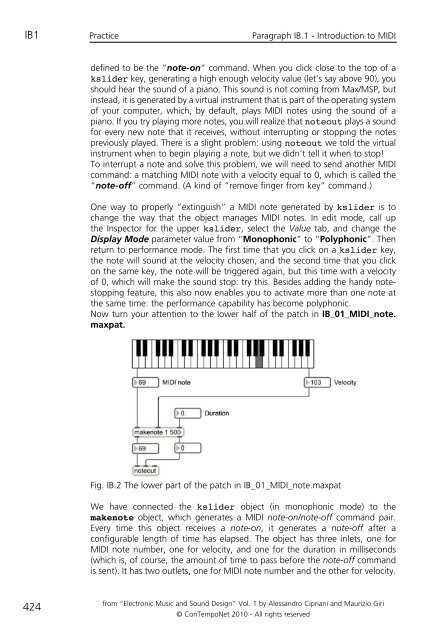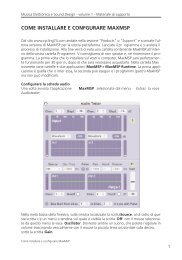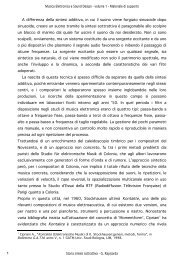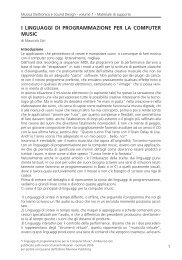programming with max/msp - Virtual Sound
programming with max/msp - Virtual Sound
programming with max/msp - Virtual Sound
Create successful ePaper yourself
Turn your PDF publications into a flip-book with our unique Google optimized e-Paper software.
IB1<br />
424<br />
Practice<br />
defined to be the “note-on” command. When you click close to the top of a<br />
kslider key, generating a high enough velocity value (let’s say above 90), you<br />
should hear the sound of a piano. This sound is not coming from Max/MSP, but<br />
instead, it is generated by a virtual instrument that is part of the operating system<br />
of your computer, which, by default, plays MIDI notes using the sound of a<br />
piano. If you try playing more notes, you will realize that noteout plays a sound<br />
for every new note that it receives, <strong>with</strong>out interrupting or stopping the notes<br />
previously played. There is a slight problem: using noteout we told the virtual<br />
instrument when to begin playing a note, but we didn’t tell it when to stop!<br />
To interrupt a note and solve this problem, we will need to send another MIDI<br />
command: a matching MIDI note <strong>with</strong> a velocity equal to 0, which is called the<br />
“note-off” command. (A kind of “remove finger from key” command.)<br />
One way to properly “extinguish” a MIDI note generated by kslider is to<br />
change the way that the object manages MIDI notes. In edit mode, call up<br />
the Inspector for the upper kslider, select the Value tab, and change the<br />
Display Mode parameter value from “Monophonic” to “Polyphonic”. Then<br />
return to performance mode. The first time that you click on a kslider key,<br />
the note will sound at the velocity chosen, and the second time that you click<br />
on the same key, the note will be triggered again, but this time <strong>with</strong> a velocity<br />
of 0, which will make the sound stop: try this. Besides adding the handy notestopping<br />
feature, this also now enables you to activate more than one note at<br />
the same time: the performance capability has become polyphonic.<br />
Now turn your attention to the lower half of the patch in IB_01_MIDI_note.<br />
<strong>max</strong>pat.<br />
Fig. IB.2 The lower part of the patch in IB_01_MIDI_note.<strong>max</strong>pat<br />
We have connected the kslider object (in monophonic mode) to the<br />
makenote object, which generates a MIDI note-on/note-off command pair.<br />
Every time this object receives a note-on, it generates a note-off after a<br />
configurable length of time has elapsed. The object has three inlets, one for<br />
MIDI note number, one for velocity, and one for the duration in milliseconds<br />
(which is, of course, the amount of time to pass before the note-off command<br />
is sent). It has two outlets, one for MIDI note number and the other for velocity.<br />
from “Electronic Music and <strong>Sound</strong> Design” Vol. 1 by Alessandro Cipriani and Maurizio Giri<br />
© ConTempoNet 2010 - All rights reserved<br />
Paragraph IB.1 - Introduction to MIDI







